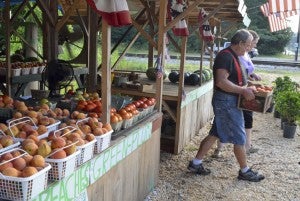Chilton County peaches thrive in summer heat
Published 4:43 pm Friday, July 17, 2015

Ray’s Produce in Maplesville sells fresh Chilton County peaches from McGraw Farms. (Photos by Whitney Denson)
This year’s booming-crop has been in the making since last year’s unusually late season ended.
According to Chilton Research and Extension Center Director Jim Pitts, the peaches did not undergo a “big freeze,” or prolonged periods of freezing temperatures, this winter, which set the stage for a flourishing crop.
Instead, the peaches received plenty of sun and rain, and have yet to be damaged by the rising July temperatures.
Though the heat may not harm the crop, it could definitely speed up the ripening process, Pitts said.
“Compared to last year, the peaches have been a lot better,” Pitts said. “The size is good. The rain has been falling good. The heat has sped up, so that may rush the season along a little bit.”
When comparing the season to a track, Pitts said farmers are “coming around the corner, onto the last stretch,” as the last month or two of the season quickly approaches.
Pitts said varieties such as July Prince and Crest Havens can be found around the county right now, and people can expect to see the August Prince and Alberta varieties hit the shelves soon, along with other varieties that will vary among growers.
In response to the possible connection between the California drought and Chilton County peaches, Pitts said he believes the relationship between the two is slight, if existent as of right now.
However, if the drought continues in coming years, Chilton County could see an even larger boost in sales, if California grocers are forced to seek produce grown outside of the state.
“Our farmers here mostly sell to smaller stores or retail markets. The drought could be a help for [the local farmers], but farmers in California are pretty resourceful, and they are already monitoring the water supply,” Pitts said. “It could certainly have an impact if it continued.”
Because California alone regularly produces more peaches than all other states in the U.S. combined, it is unlikely that the drought has created a despondent situation for California peach farmers already, Pitts said.
Todd’s Produce Owner Dordie Hayes echoed Pitts in saying that she has not seen any direct correlation with the drought, but also doesn’t think it out of the realm of possibility.
“We send our peaches to all of the neighboring states, and even to Texas,” Hayes said. “Where they go from there, we don’t know.”
Hayes estimated that the season will last approximately six more weeks, which will see the business through Labor Day, a holiday that usually marks the end of the season for Todd’s Produce and many other sellers.
“We’ve got a much better peach crop this year. Last year, they were damaged by the freeze,” Hayes said. “It’s been awesome. Every peach we pick is gone soon after it goes on the shelf.”
Hayes said both the wholesales and retail sales are up.
“You have some good years and some bad,” Hayes said. This is a good year for us, and I feel for those dealing with a bad one.”
Culp Fruits owner Angie Glass said that she, too, had no complaints about this year’s crop.
“We’re going full speed right now,” Glass said. “We have clear-seed varieties right now. They’re a big, pretty peach. Great for canning and freezing, too.”
Glass said Culp Fruits is currently harvesting the Haveth, Alberta and Parade varieties.
While farmers in the county are shipping peaches all over the Southeast, fruit stands in Chilton County are also reaping the benefits from the abundant crop.
One of these fruit stands is Ray’s Produce in Maplesville, which sits just inside the Maplesville town limits on Highway 22.
Owner Ray Pairett started selling peanuts and tomatoes at the small stand in 2012, but started selling peaches when people began stopping and asking for them.
“The peaches come from McGraw Farms [in Maplesville],” Pairett said. “I’ve always had good business at my stand, and I have regulars that stop by all the time.”
According to Pairett, it’s most likely the convenient location that draws in the business from both his Maplesville customers and out-of-towners coming through.
“Prices are about the same as they’ve always been, but the peaches look better than ever,” Pairett said.







